- Interesting facts about the red currant
- Health berry
- Contraindications
- Therapeutic properties and excellent taste
Originally red currant was grown exclusively for medicinal purposes, so the West European pharmacists knew well from the earliest times about the curative properties of red currant berries. Now this beautiful frost-resistant culture grows in the Czech Republic, Germany, France, the Netherlands, Belgium, Britain, Austria.
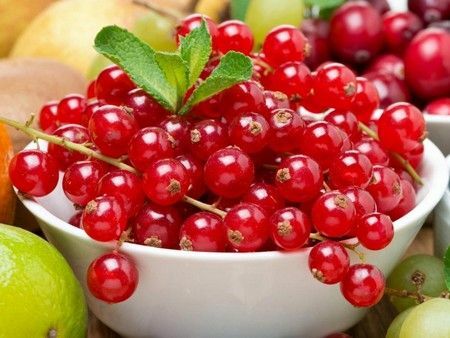
In Russia, this garden deciduous shrub began to be cultivated from the XI century, mainly in monasteries( for example, in Novgorod and Pskov).Records about this have been preserved in the annals. So the red currant and took its niche in the Russian culture of nutrition and traditional medicine. Then it began to grow in manors and gardens. The motherland of the currant is considered to be Siberia, and now the Volga, the South of Russia, the Urals, the middle belt and even the Far East are famous for high yields of bright and healthy berries. It is known that in our country they grow up to 60% of the world currant.
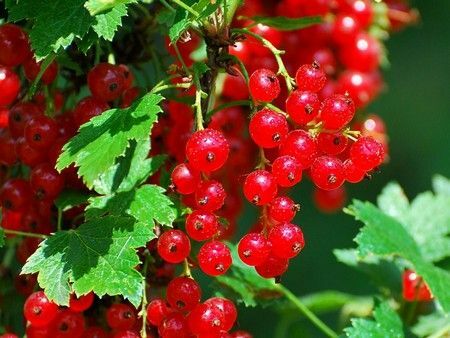
The currant bush is a hardy perennial, and with proper care( it does not tolerate shade) and good watering can bring joy to more than one generation of gardeners and successfully bear fruit up to 20years in a row. The first small crop of currant brings in the second year, and from one mature bush it is possible to collect from 3-4 to 7-9 kg. Flowering begins in May, and the fruit ripens in July.
In the "wild" form there are up to 150 species of this shrub. In modern Russian catalogs for gardeners, there are up to 70 different varieties of red currant, including quite exotic varieties - with colorless, white, pink, pomegranate-red or dark, almost black berries. The most popular modern varieties with excellent taste qualities are:
- Red Currant: Generous, Ural beauty, Seryozhka, Rachnova, Dawn, Early sweet, Summer gift, Urals Lights, Hope, Natalie, Alpha, Valentinovka, Viksne, Konstantinovskaya.
- White currant: Yuterborgskaya, Smolyaninovskaya, White fairy, Minusinskaya white.
- Pink currant: Rose, Sprinkler.
The photo shows one of the old varieties of red currant - early Chulkovo currant of national selection.
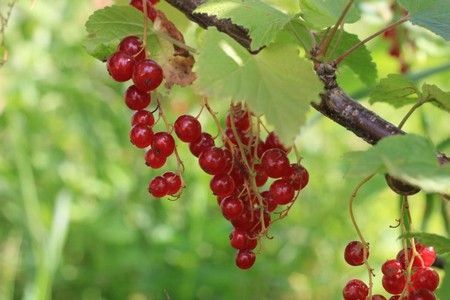
Interesting facts about red currant
Black, white and red "varieties" of currant berries can be simultaneously found in the garden - from immature, but more saturated with vitamin C, to tastyripe varietal fruits. That's why you need to know about some of the nuances and differences of these cultures.
- The Latin name for the currant "Ribes" comes from. .. the Arabic name for rhubarb( "ribas").It is known that during the conquest of Spain in 711 the Arabs tried the sour red berries, the taste of which remotely reminded them of the rhubarb habitual for their diet. In such an amazing way this name was officially fixed for all kinds of currants.
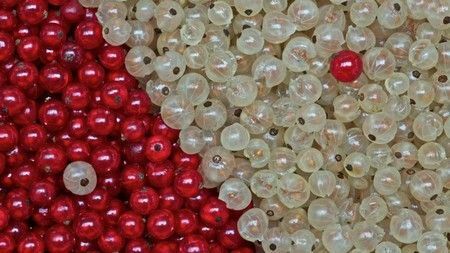 White currant is a "neutral" variety of red, botanical "albino";life cycles and appearance of shrubs are identical, and the fruits differ in color and chemical composition, but slightly
White currant is a "neutral" variety of red, botanical "albino";life cycles and appearance of shrubs are identical, and the fruits differ in color and chemical composition, but slightly - If you carefully consider the different types of currant, you can note this rainbow of colors - in addition to the known three varieties, there is also yellow orange, purple and even greenripe!) currant. A distinctive feature of berries is not only the color, but also the taste, as well as the biochemical composition. So, the "American" red currant, surprisingly sweet to the taste, has a black color, and its pulp resembles a kind of semolina porridge.
- It's not for nothing that the green currant has its "admirers" - it contains 4 times more active vitamin C, which protects against infections and diseases, effectively supports immunity. As the ripening "activity" and the concentration of vitamins in berries decreases, and when overripe fruits and do become useless.
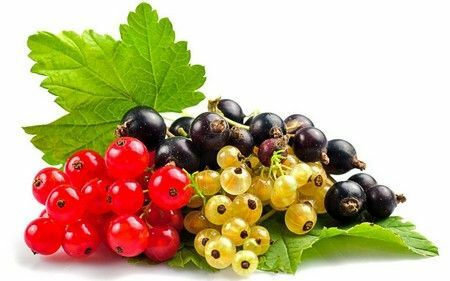
Health berry
Despite the fact that thanks to the development of chemistry and pharmaceutics, many medical advances have been scientifically justified in the XIX-XX centuries, for a long time people knew what the red currant is useful for and what medicinal qualities are inherent in it. Thus, the use of this scarlet berries in raw form, juices and fruit drinks from it is shown in such diseases and conditions as:
- of heart disease and blood vessels;
- Vitamin C hypovitaminosis( 100 mg of currant contains up to 25 mg of this vitamin!), Weakened immunity;
- fever, colds, SARS, inflammatory throat diseases, nasopharynx;
- decreased appetite, oppression of the gastrointestinal tract;
- dry mouth, thirst, nausea.
Multifunctional effects on the human body of currant preparations are possible due to the rich chemical composition of ripe scarlet berries. The substances contained in red currant have the following useful properties:
- The unique substance of oxycoumarin, which exists only in the "red" variety of berries, helps to normalize the process of blood coagulability, which is useful for the prevention of strokes, heart attacks, thromboses.
- Thanks to the high content of pectins, the body is left, harmful cholesterol, which is favorable for the prevention of the appearance of vascular "plaques" and, as a consequence, atherosclerosis. Also, organic acids and pectins neutralize the effects of the increased radiation background.
- Red currant has a good choleretic and diuretic effect, relieves swelling, effectively increases metabolism and cleanses the intestines.
- Natural antioxidants( vitamins A, C, E, selenium) help to fight the formation of cancer cells and slow down the rapid aging processes of body cells. In addition to these nutrients, red currant juice and pulp contain flavonoids, catechins, anthocyanins, vitamin H-biotin( 2.5 μg), vitamin PP( 0.3 mg), mono- and disaccharides( 7.7 g), dietary fiber3.5 g), saturated and unsaturated fatty acids( 0.1 g), B vitamins, nicotinic acid, iron( 0.9 mg), iodine, calcium( 36 mg), sodium( 21 mg), phosphorus( 33 mg), magnesium( 17 mg), potassium( up to 275 mg), as well as vitamin K, involved in the process of blood clotting.
Red currant for expectant mothers
Despite this sufficiently saturated biochemical composition, it is known that red currant does not cause allergies, so in the season it can be useful for feeding pregnant women. The juice of fresh berries is an effective means of combating early toxicosis, discomfort in the stomach and a feeling of nausea.
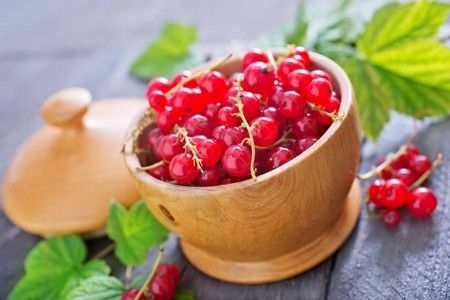 100 g of fresh berries contain up to 85% of water, and their caloric content is 43-50 kcal, which allows you to safely consume red currant during the period of the
100 g of fresh berries contain up to 85% of water, and their caloric content is 43-50 kcal, which allows you to safely consume red currant during the period of thediet. Tip: The juice of this berry has bleaching properties that can be useful for those inconnection with the "interesting" position showed pigment spots on the face and body. During breastfeeding, hair loss increases, adjusting this process and speeding up the renewal of the hair cover will help mask of red currant juice.
Contraindications
Despite the obvious benefits of red currant to preserve human health, one should not forget about the harm that can be caused by its use for an organism already affected by the disease. Contraindications to the reception of this fruit-rich berries are:
- in the acute stage - gastritis, gastrointestinal ulcers;
- hepatitis;
- sensitivity of tooth enamel;
- hemophilia, low coagulability of blood cells.
The healing properties and excellent taste of
It is known that every disease has its own medicine. In the case of the red currant, there are also certain therapeutic "preferences" and patterns. So, the use of jams and tea is indicated for relief of the condition with hypertension, gastritis, oppressed immunity. Here are some recipes for such useful and tasty "preparations".
A recipe for toning tea for hypertension
It is required: dry leaves( 1 tablespoon), fresh or frozen currant fruit( 2 tablespoons), rosemary( 1 sprig), mint( 2 sprigs) boiling water( 500 ml).
Preparation: Grind the berries in puree. Pour the herbal raw materials with boiling water in a teapot, add the ground currant, let it brew for 10 minutes. Drink 2-3 cups a day, to taste adding honey.
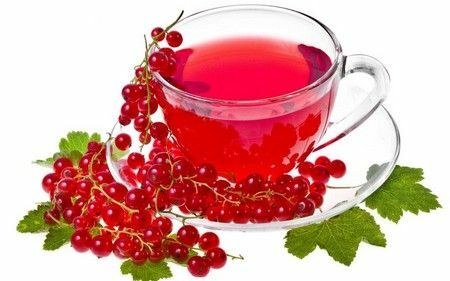 Tea with the addition of leaves and red currant berries is an excellent remedy for the prevention of heart and vascular diseases.
Tea with the addition of leaves and red currant berries is an excellent remedy for the prevention of heart and vascular diseases.A recipe for compote from red currant
. It is required: currant berries( 500 g), sugar( 250 g), water( 2 l).
Preparation: Rinse the berries and leave to drain. Boil water in a saucepan, add sugar and, after dissolving it, cover berries. Boil for 2-5 minutes, turn off the heat and leave to cool under the lid. Insisting, compote becomes tastier.
Tip: You can add other fruits to the compote of red currant: gooseberry, cranberry, black currant, cherry, apples. It is reasonable to replace sugar with honey.
Recipe for red currant Morrus's
It is required: red currant berries( 500 g), sugar( 50 g), water( 1.5 l).
Preparation: Rinsed berries crush with a pistil and rub through a sieve - should be about 150-200 ml of juice. The remaining cake should be transferred to a pan, pour water, add sugar and boil after boiling for 5 minutes. The broth completely cool. When serving in a glass, pour the juice( 25-50 g), top up the sweet broth, decorate with a branch of fresh currant.
Advice: You can wipe not fresh, but slightly scalded currant fruit( dip into boiling water for 2 minutes).Then the berry broth turns out to be more saturated.
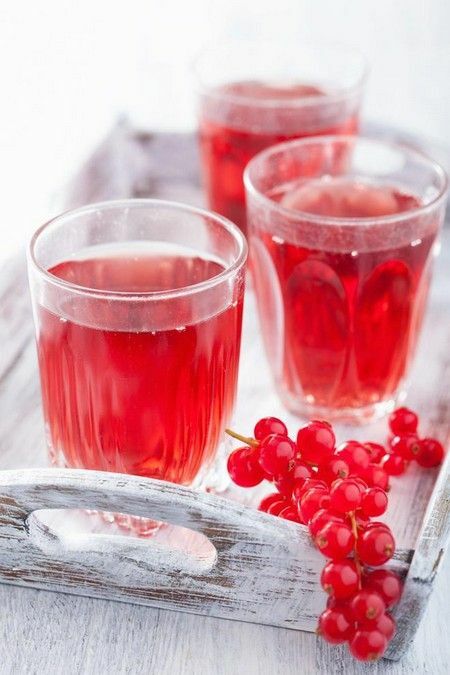 Red currant Morse - a useful refreshing "summer" drink
Red currant Morse - a useful refreshing "summer" drinkDrinking berries in fresh form is the best way to saturate the body with useful nutrients that the red currant is famous for. However, a significant part of vitamins is preserved as a result of the processing of berries - during frost, canning, preparation of drinks, jams, jellies, desserts and other delicacies.
On valuable properties and possible contra-indications of the "berries of health" of red currants you can find out by watching the video:
